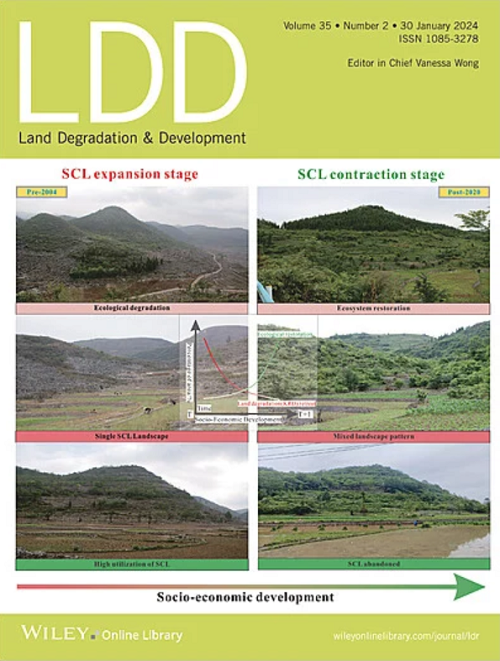Biochar as a Long‐Term Strategy for Rehabilitating Degraded Soils: Multi‐Omics Analysis of Soil–Metabolite–Microbe Interactions in Continuous Soybean Cultivation
IF 3.6
2区 农林科学
Q2 ENVIRONMENTAL SCIENCES
引用次数: 0
Abstract
Biochar shows significant promise as a soil amendment for enhancing soil fertility and crop yield, but its long‐term influence on soil–metabolite–microbe interactions in continuous soybean systems remains underexplored. In this decade‐long field study, we investigated the effects of different biochar doses (CA: biochar, 12 t·ha生物炭作为恢复退化土壤的长期策略:大豆连作中土壤-代谢物-微生物相互作用的多组学分析
生物炭作为一种土壤改良剂在提高土壤肥力和作物产量方面显示出巨大的前景,但其对连续大豆系统中土壤-代谢物-微生物相互作用的长期影响仍未得到充分研究。在这项长达十年的实地研究中,我们研究了不同剂量的生物炭(CA:生物炭,12 t·ha−1;CB:生物炭,24 t·ha−1)与常规施肥(CF)对土壤特性、微生物群落和根际代谢物的影响。结果表明,生物炭对土壤特性的改善表现出剂量依赖性,包括孔隙度、pH值、有机碳含量、养分有效性和酶活性的增强,同时降低了容重。值得注意的是,生物炭的应用重组了微生物群落,炭黑处理丰富了有益微生物(MND1、Ellin6067、Vicinamibacteraceae和Conocybe),同时抑制了潜在的病原体(Ceratobasidium和Cyathus)。同时,生物炭诱导了根际代谢组的显著调节,特别是对单萜类生物合成途径和植物防御机制的影响,代谢产物的改变与土壤性质的改善密切相关。多组学网络分析揭示了一种级联效应,即生物炭修饰的土壤特性增强了有益代谢产物(例如(−)‐3‐脱氢山竹酸和叔丁基对苯二酚),同时抑制了D‐泛硫酸盐、4‐吡哆酸盐和(−)‐α‐蒎烯,导致有益微生物群落(Conocybe和Vicinamibacteraceae)增加,病原体(Cyathus)减少。我们的研究结果为生物炭对土壤生态环境的长期影响提供了新的见解,并为大豆连作下退化土壤的可持续恢复提供了创新的策略。
本文章由计算机程序翻译,如有差异,请以英文原文为准。
求助全文
约1分钟内获得全文
求助全文
来源期刊

Land Degradation & Development
农林科学-环境科学
CiteScore
7.70
自引率
8.50%
发文量
379
审稿时长
5.5 months
期刊介绍:
Land Degradation & Development is an international journal which seeks to promote rational study of the recognition, monitoring, control and rehabilitation of degradation in terrestrial environments. The journal focuses on:
- what land degradation is;
- what causes land degradation;
- the impacts of land degradation
- the scale of land degradation;
- the history, current status or future trends of land degradation;
- avoidance, mitigation and control of land degradation;
- remedial actions to rehabilitate or restore degraded land;
- sustainable land management.
 求助内容:
求助内容: 应助结果提醒方式:
应助结果提醒方式:


